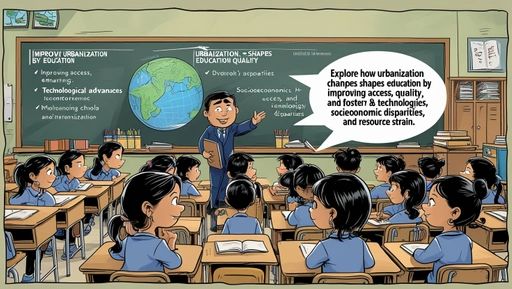Introduction Urbanization is a transformative global phenomenon that reshapes societies and economies. It refers to the increasing movement of people from rural to urban areas, leading to the expansion of cities and towns. While urbanization has many implications, one of the most significant impacts is on education. The relationship between urbanization and education is complex, influencing access to schools, quality of learning, educational infrastructure, and disparities in educational opportunities. This article explores the various dimensions of urbanization’s impact on education.
Improved Access to Education One of the most evident benefits of urbanization is improved access to education. Cities and towns generally have a higher concentration of educational institutions, ranging from primary schools to universities. This proximity allows students to access schools without facing the long commutes that rural students often endure. Additionally, urban areas offer diverse educational opportunities, including specialized schools and vocational training centers that cater to a broad range of learning needs.
Enhanced Quality of Education Urbanization fosters improvements in the quality of education. Urban schools typically attract well-qualified teachers, better resources, and more diverse extracurricular activities. The presence of technology in classrooms, such as digital learning tools and smart boards, further enhances the learning experience. Additionally, urban students benefit from exposure to various cultures, perspectives, and ideas, leading to a more enriched educational environment.
Increased Government and Private Investment Urban areas often receive higher investments in education from both government and private sectors. Governments prioritize urban education due to population density, ensuring better infrastructure, teacher training programs, and modern curricula. Private institutions, including international schools and universities, also thrive in urban settings, offering quality education options. This investment helps in curriculum development, research initiatives, and educational reforms that benefit urban students.
Challenges Posed by Urbanization on Education Despite its advantages, urbanization also presents challenges for education systems. The rapid increase in population puts pressure on educational infrastructure, leading to overcrowded classrooms and inadequate resources. Schools struggle to accommodate the growing number of students, often resulting in higher student-to-teacher ratios and reduced personalized learning.
Socioeconomic Disparities in Education Urbanization exacerbates socioeconomic disparities in education. While affluent families can afford private schools with superior facilities, low-income families struggle to access quality education. Public schools in low-income urban areas often face challenges such as underfunding, outdated resources, and poorly maintained facilities. This disparity creates a gap in educational achievement and future opportunities for students from different economic backgrounds.
Impact on Rural Education As urbanization attracts people to cities, rural areas experience a decline in population, affecting their education systems. Many rural schools suffer from teacher shortages as educators migrate to urban centers for better career prospects. The lack of students in rural areas leads to school closures, further limiting educational opportunities for children left behind. This migration also impacts rural communities’ overall development, as fewer educated individuals remain to contribute to local progress.
Technological Advancements in Urban Education Urbanization has led to the integration of technology in education. Online learning platforms, digital libraries, and smart classrooms are more prevalent in urban schools, providing students with advanced learning tools. The availability of high-speed internet and digital devices facilitates remote learning, bridging educational gaps. However, the digital divide remains an issue, as students from low-income backgrounds may lack access to these technological advancements.
Higher Education and Research Opportunities Cities serve as hubs for higher education and research. The presence of universities, research institutions, and innovation centers attracts students from across the country and the world. These institutions contribute to academic advancements, technological innovations, and skill development, strengthening the education sector. The collaboration between industries and educational institutions in urban areas also enhances career opportunities for graduates.
Impact on Teacher Training and Development Urbanization promotes teacher training and professional development. Urban centers provide access to workshops, training programs, and higher education institutions that enhance educators’ skills. Teachers in urban areas have more opportunities to collaborate with peers, engage in research, and adopt innovative teaching methodologies. This professional growth leads to improved teaching quality and student outcomes.
Environmental and Health Concerns Affecting Education Urbanization brings environmental challenges such as pollution, overcrowding, and poor living conditions, which can impact students’ health and ability to learn. High levels of air pollution in cities can lead to respiratory issues, affecting school attendance and concentration. Noise pollution and congested living spaces also contribute to stress and hinder students’ learning experiences. Addressing these issues is crucial to ensuring a healthy and conducive educational environment.
Government Policies and Urban Education Reforms Governments play a vital role in managing the impact of urbanization on education. Policies aimed at improving public schools, reducing student-to-teacher ratios, and increasing funding for low-income schools help bridge the education gap. Urban planning strategies that include educational infrastructure development ensure that growing populations have access to quality education. Additionally, initiatives promoting inclusive education address disparities and provide equal opportunities for all students.
Future Implications of Urbanization on Education As urbanization continues to expand, education systems must adapt to evolving needs. The integration of smart technologies, flexible learning models, and sustainable education policies will shape the future of urban education. Ensuring equitable access to education for all socioeconomic groups remains a priority. Governments, educators, and communities must work together to create inclusive and effective education systems that cater to urban populations’ diverse needs.
Conclusion Urbanization significantly impacts education, offering both opportunities and challenges. While it enhances access to quality education, fosters technological advancements, and attracts investment, it also exacerbates disparities and strains infrastructure. Addressing these challenges through policy reforms, increased funding, and innovative teaching methods is essential for ensuring that urban education benefits all individuals. By embracing sustainable and inclusive education models, societies can maximize the positive impact of urbanization on learning and development.

6 thoughts on “Impact of Urbanization on Education”
Comments are closed.